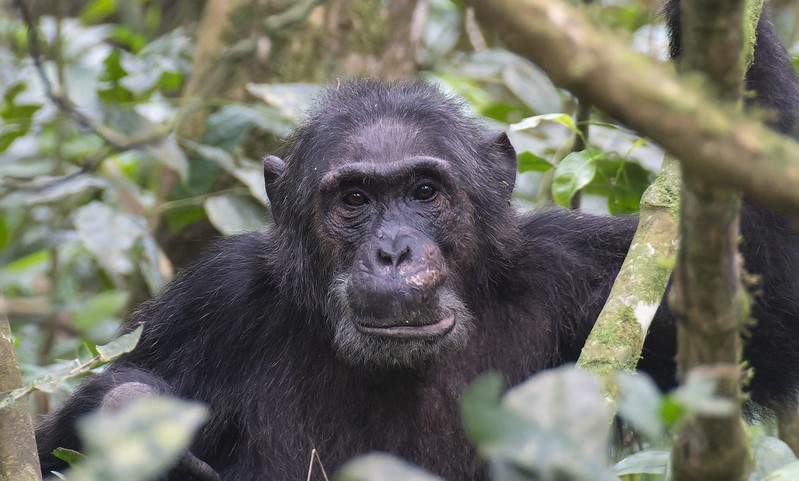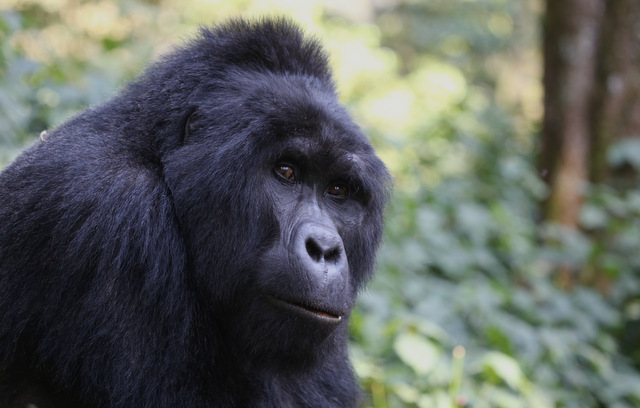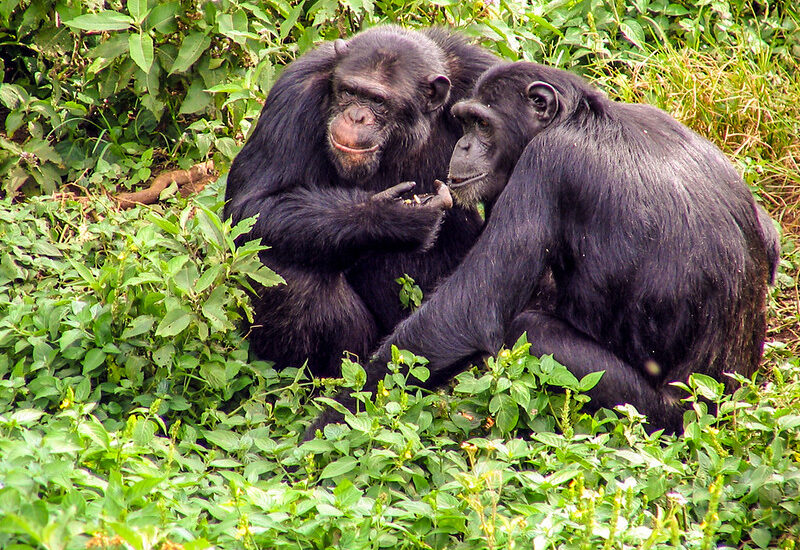Uganda chimpanzee trekking – Chimpanzee trekking safaris in Kibale forest National park – Budget safaris…
Kibale forest chimpanzee tracking
Kibale forest chimpanzee tracking – Gorilla trekking tours in Uganda.
At an elevation of 1,590 meters above sea level, Kibale is the highest point in the park, making it an ideal location for chimpanzee tracking in the Kibale forest. On the southern side, in the Albertine Rift Valley, you’ll find the lowest point at 1,100 meters.
The park is home to 351 different types of trees, some of which are over 200 years old and reach heights of 55 meters. Kibale’s varying height supports a variety of habitats, from woodlands and grassland on the rift valley bottom to wet tropical forest on the Fort Portal plateau.
Among the most important research locations in Africa is Kibale. There are a lot of people studying chimpanzees, but there are other ecosystems on Kibale, wild pigs, and several kinds of fish.
One of Uganda’s most beautiful and diverse tropical forest tracts is located in Kibale National Park. On a high plateau, the park’s northern and center sections are mostly forested, with some grassland and wetland areas scattered throughout. Famously, Kibale is recognized for his work in chimpanzee tracking.
There are 70 different kinds of mammals in the park, with 13 different kinds of primates, including the chimpanzee, being the most well-known.
There are more than three hundred and seventy-five bird species there as well.
CHIMPANZEE INFORMATION
We share more than 98% of our DNA with chimpanzees, making them one of our closest cousins. Chimpanzees usually live in groups of fifteen to twenty, yet some may be as big as a hundred, and every group has its own distinct character. Because of their intelligence, sociability, and communication skills, chimpanzees thrive in social groups.
These groups, which are often headed by a dominant male, allow the chimpanzees to get the emotional and cerebral stimulation they need. Being one of the few species capable of toolmaking, they rely on nonverbal cues such as posture, gait, and the sounds produced by their beaks, pants, and hoots to convey meaning. Chimpanzees are clever creatures who often use pebbles to crack nuts or open fruits, or to dig insects out of tight places.
![]()
This helps ensure that they consume a wide variety of foods, including fruits, vegetables, eggs, meat, and even carrion, in addition to insects and other plants. Furthermore, with an average lifespan of forty years, wild chimpanzees have more than enough time to transmit their unique abilities to subsequent generations.
Tracking chimpanzees in Uganda’s Kibale forest
Before setting out on your chimpanzee trekking trip, park rangers will meet at 8 AM for a briefing. A maximum of eight clients may be escorted by a single armed ranger.
Timing of a Kibale Forest Visit
Because of its location on the equator, Uganda has consistently warm weather, with highs in the 80s throughout the year. Humidity is high, particularly in hilly regions where hiking is done. During the rainy season (April–May), chimpanzee trekking is least crowded. No matter the season, you can expect to get wet when walking through a jungle. The months of June through October are the busiest for tourists visiting Uganda, but they are also the greatest if you’re looking for drier weather.
What to pack for a chimpanzee adventure
A compact daypack with essentials
Snacks according to your taste
Snapping a picture. Take as many pictures as you want—just don’t use the flash, we promise!
Waterproof boots that won’t give way are ideal for muddy terrain.
Stylish, long-lasting coat
Adaptable layers to keep warm in the summer and dry in the winter. If you’re going to be hiking through any thorny vegetation, it’s best to dress in long sleeves and slacks.
An insecticide
Important information on chimpanzee tracking in the Kibale forest
Make sure to schedule your permissions ahead of time with our advisors.
Please do not enter the park if you are sick—the flu, anyone—in order to protect the chimpanzees from human-borne infections.
At Kibale Forest National Park, chimpanzee trekking is only available to those 12 and over.
Maintain a minimum distance of 8 meters while in the vicinity of chimpanzees.
Refrain from sharing a meal with the apes.
Always pay attention to your guide; they are the ones who know the area best.
The usual number of trekkers is eight.
Comparing Chimpanzee and Gorilla Trekking
Chimpanzees spend a disproportionate amount of time in trees, which is the most crucial consideration when comparing trekking with gorillas. In contrast to the ground-dwelling gorillas, chimpanzees spend much of their time zipping up and down the treetops.
Even while it’s exciting to watch them construct nests or sway through the trees, it may be challenging to identify them, take decent shots of them, and even damage your neck! Accepting that your images won’t be perfect is sometimes all it takes to just enjoy seeing them. But we did get some decent ones!
The chimpanzees were more energetic and noisy than the gorillas, in my opinion. In contrast to my gorilla trekking experience, this one puts you right in the middle of the troop, encircling you, and making the whole thing that much more fascinating.
Despite the deep jungle, the chimpanzee journey was far easier than the gorilla excursion. The less demanding nature of the hike allowed me to savor the scenery, listen to the birds, and see the monkeys without exerting myself too much.
Similar to gorilla tracking, chimpanzee tracking also needs a permission, and there is a daily limit on the total number of permits. Groups visiting Kibale are limited to six people. You may see the chimpanzees in the morning or the afternoon, unlike gorilla trekking, which requires longer hikes. While some argue that visiting in the morning is preferable since chimpanzees become drowsy in the afternoon, others maintain that the time of day makes no difference.
We visited first thing in the morning, and wow, were those things lively! Wear sturdy shoes and layers, including rain gear, much as you would for a gorilla climb. To protect yourself from the pesky safari ants, use gaiters or tuck your jeans into your boots. You should also use gardening gloves to protect yourself from stinging nettles.
Comparing the experiences of chimpanzee tracking and habituation
You may spend a whole day with the chimpanzees at Kibale, where you can participate in research and the habituation process with specialists from the Uganda Wildlife Authority. This is in addition to the chimpanzee trekking that Kibale provides. Primate fans would find it an enthralling event.
Spending the day with a troop of chimpanzees is an essential part of the habituation process. You get to know the group’s dynamics, members’ quirks and habits, and form genuine bonds with them over this period. Gain practical experience in fieldwork and gain knowledge about behavioral research via this opportunity.
Accompanying guests on the habituation experience are rangers and guides from the University of Western Australia (UWA). These individuals have extensive knowledge of the chimpanzees and can answer any questions guests may have while also providing background on the group’s evolution. Because of the extensive time spent with the apes, chimpanzee habituation provides a more immersive experience than chimpanzee trekking.
Alternatively, you may have a traditional Ugandan meal at the home of a community leader or go on a nature walk through the Bigodi Wetlands.
Lodging options close to Kibale Forest
I stayed at Ndali Lodge, Primate Lodge, and Kyaninga Lodge, all of which are fantastic options near Kibale. What really sold it for me was the property’s elevated wooden walkways. It has spacious accommodations with breathtaking views of a Crater Lake, as well as excellent cuisine and friendly service.
Everything is calm and tranquil here. For more information on wildlife safaris, gorilla trekking, and chimpanzee tracking in the Kibale forest, as well as other tours in Uganda, Monumental Expeditions and Safaris is the best tour operator to choose.


